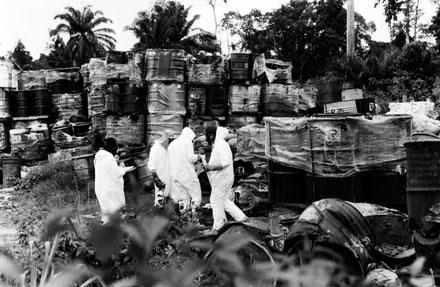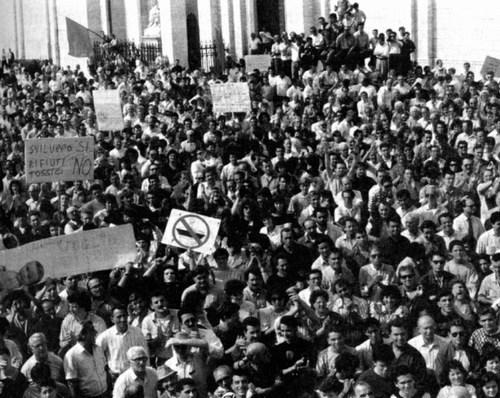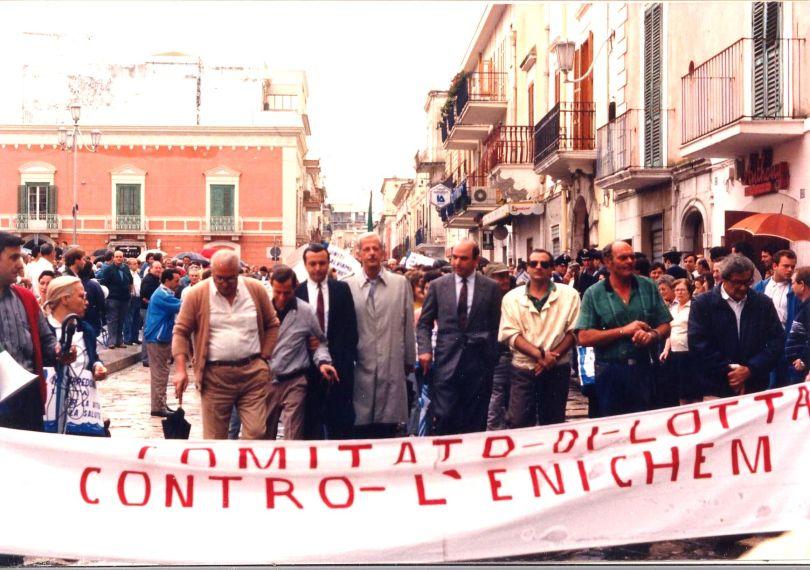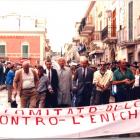The globalization of hazardous waste has been permeating international debates since the 1980s, when it began as a global phenomenon, normally involving firms from the Global North stipulating trade agreements with Global South countries with looser environmental regulations. The Koko incident involving the trading of chemical waste from Italy to Nigeria was a pivotal moment in the formulation of the first international regulations on hazardous waste. However, the incident also had strong repercussions in the Global North, sparking a fight for environmental justice in Italy that would eventually lead to the improvement of national regulatory frameworks.
In May 1988, Nigerian authorities found over two thousand drums of toxic waste in the small fishing village of Koko, located on the Niger Delta. The hazardous waste brought to Koko belonged to the Italian oil companies Jelly Wax and Ecomar (based in Milan and Verona, respectively) and was transported to Nigeria by a Trojan horse enterprise owned by Italian entrepreneur Gianfranco Raffaeli. The barrels contained hazardous chemical materials such as a dioxin-producing combustible known as polychlorinated biphenyl (PCB), as well as dimethyl formaldehyde and asbestos fibers. In Koko, the corroding barrels were stored in the backyard of an unsuspecting farmer. Soon, they started leaking and contaminated soils and groundwater, making several villagers seriously ill. The international outcry about the incident was enormous, sparking a pan-African debate about “toxic colonialism.” In retaliation, Nigeria also held an Italian ship hostage and withdrew its ambassador.

Toxic waste in the Port of Koko.
Toxic waste in the Port of Koko.
Unknown photographer, n.d.
Courtesy of archivio Amici della Terra.
Click here to view source.
All rights reserved.
The copyright holder reserves, or holds for their own use, all the rights provided by copyright law, such as distribution, performance, and creation of derivative works.
Back in Italy, the Koko incident was extensively covered by the national press from the beginning. According to reconstructions, Italy had failed to comply with the OECD’s recent regulations on hazardous waste, which required entrepreneurs to notify the corresponding regional sections of the Ministry of the Environment of any hazardous waste disposal. The Koko incident was clearly the result of a collapsing national waste disposal system. As the Christian Democratic government found itself in the difficult position of solving a diplomatic crisis with Nigeria, a massive NIMBY (“Not In My BackYard”) movement spread all over Italian port cities. Although the waste drums had originated in Italy, people now refused to take them back. They opposed receiving the two cargo ships carrying the toxic drums to Italy, the Karin B and Deep Sea Carrier, which became known as navi dei veleni (poison ships) or navi dei rifiuti (waste ships).
After ruling out a military port, local and national policymakers designated the port city of Livorno to receive the Karin B, a choice motivated by the presence of the specialized chemical industry Monteco. Environmental organizations such as Greenpeace and Legambiente worked in conjunction with the government in order to convince the local population. The Karin B officially entered the port of Livorno on 20 September 1988, about three months after sailing from Nigeria.
A less fortunate destiny was reserved for the Deep Sea Carrier, destined for the town of Manfredonia. After learning about the city council’s compromise to welcome the ship in the local port, the population went on a prolonged strike that lasted from the end of September 1988 to the beginning of November. As well as closing all businesses, schools, and several public streets, the local population went so far as to put the major’s office under siege. The press described Manfredonia as a “torched city.”

Demonstrations in Manfredonia against the Deepsea Carrier.
Demonstrations in Manfredonia against the Deepsea Carrier.
Unknown photographer, 1988.
Accessed via Il Lavoro Debilita. Click here to view source.
 This work is licensed under a Creative Commons Attribution-NonCommercial-ShareAlike 4.0 International License.
This work is licensed under a Creative Commons Attribution-NonCommercial-ShareAlike 4.0 International License.
Such a tough display of force was the result of marked socio-environmental scars in the city. EniChem, the petrochemical company in charge of disposing of the toxic waste, had already been involved in several scandals related to the illegal dumping of toxic waste in and around the city since the mid-1970s. These included the release of arsenic trioxide in the atmosphere and the massive pollution of local aquifers, generating sanitation issues such as an above-average rate of lethal diseases related to arsenic exposure. During the 1988 protests against the landing of the “poison ship,” this unsolved socio-environmental conflict resurfaced. Suddenly, an urban community numbed by almost 15 years of traumatic contamination events converged in a unified movement for environmental justice.
After months of negotiations between politicians, local committees, and environmentalist organizations, the port city of Taranto accepted the ship on 5 April 1989. Months of massive public outcry led to national regulations on the circulation and disposal of hazardous waste. In particular, a decree (no. 397) passed on 9 September 1988 instituted an official register of special waste, compelling national companies to keep records of the debris produced and disposed. Meanwhile, in Manfredonia, a local coalition managed to force the dismantlement of EniChem by 1993. About two years later, the World Health Organization ranked Manfredonia among the most heavily-polluted Italian cities. Negotiations for the reclamation of local soils continue to these days.

Demonstrations in Manfredonia against EniChem.
Demonstrations in Manfredonia against EniChem.
Unknown photographer, 1988.
Accessed via Il Lavoro Debilita. Click here to view source.
 This work is licensed under a Creative Commons Attribution-NonCommercial-ShareAlike 4.0 International License.
This work is licensed under a Creative Commons Attribution-NonCommercial-ShareAlike 4.0 International License.
The Koko incident has often been regarded as a defining moment in the history of hazardous waste disposal, where issues of economic externalization, environmental justice, and international diplomacy dramatically converged. Its ample media coverage led indeed to the development of cutting-edge regulatory frameworks concerning the international trade of hazardous waste, such as the Basel Convention (1989) and the Bamako Convention (1991). In Italy, it also sparked a grassroots movement for environmental justice, contributing the growth of national regulations for hazardous waste, although a comprehensive law reform on waste supply was only approved in 1997 (decree no. 22/97) and environmental crimes only became a legal felony in 2015 (decree no. 68). The multiple political and normative tools available to grassroots organizations today are therefore also a legacy of the Koko incident.
How to cite
De Majo, Claudio. “Italy’s Poison Ships: How an International Trade of Hazardous Waste Sparked a Grassroots Struggle for Environmental Justice.” Environment & Society Portal, Arcadia (Autumn 2020), no. 43. Rachel Carson Center for Environment and Society. https://doi.org/10.5282/rcc/9152.
ISSN 2199-3408
Environment & Society Portal, Arcadia
 This work is licensed under a Creative Commons Attribution 4.0 International License.
This work is licensed under a Creative Commons Attribution 4.0 International License.
2020 Claudio De Majo
This refers only to the text and does not include any image rights.
Please click on the images to view their individual rights status.
- Commissione Parlamentare di inchiesta sulle attività illecite connesse al ciclo dei rifiuti e su illeciti ambientali ad esse correlati. Relazione sulle “navi dei veleni”: i traffici dei rifiuti negli anni ’80 e ’90. Doc. 13, no. 51 (28 February 2018). (PDF)
- Corona, Gabriella. A Short Environmental History of Italy: Variety and Vulnerability. Winwick: The White Horse Press, 2017.
- D’Alisa, Giacomo, Marco Armiero, Salvatore Paolo De Rosa. “Rethink Campania’s toxic-waste scandal.” Nature 509, no. 427 (2014).
- Greenpeace Italy. Report—The Toxic Ships: The Italian Hub, the Mediterranean Area and Africa. Rome: Greenpeace Onlus, June 2010.
- MacKenzie, Debora. “Britain Could Yet Take Italian Waste.” New Scientist, 8 September 1988.
- Malavasi, Giulia. Manfredonia. Storia di una catastrofe continuata. Milan: Jaca Book, 2018.
- Müller, Simone. “Hidden Externalities: The Globalization of Hazardous Waste.” Business History Review 93, no. 1 (2019): 51–74.








